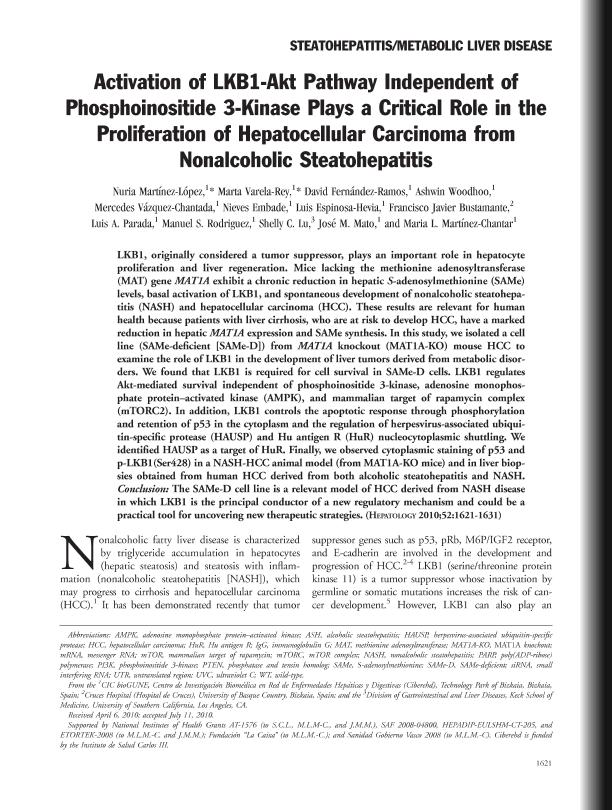Mostrar el registro sencillo del ítem
dc.contributor.author
Martínez López, Nuria

dc.contributor.author
Varela Rey, Marta

dc.contributor.author
Fernández Ramos, David

dc.contributor.author
Woodhoo, Ashwin

dc.contributor.author
Vázquez Chantada, Mercedes

dc.contributor.author
Embade, Nieves

dc.contributor.author
Espinosa Hevia, Luis

dc.contributor.author
Bustamante, Francisco Javier

dc.contributor.author
Parada, Luis Antonio

dc.contributor.author
Rodriguez, Manuel S.

dc.contributor.author
Lu, Shelly C.

dc.contributor.author
Mato, José M.

dc.contributor.author
Martínez Chantar, María L.

dc.date.available
2017-05-22T19:25:04Z
dc.date.issued
2010-10-29
dc.identifier.citation
Martínez López, Nuria; Varela Rey, Marta; Fernández Ramos, David; Woodhoo, Ashwin; Vázquez Chantada, Mercedes; et al.; Activation of LKB1-Akt pathway independent of phosphoinositide 3-kinase plays a critical role in the proliferation of hepatocellular carcinoma from nonalcoholic steatohepatitis; John Wiley & Sons Inc; Hepatology (baltimore, Md.); 52; 5; 29-10-2010; 1621-1631
dc.identifier.issn
0270-9139
dc.identifier.uri
http://hdl.handle.net/11336/16814
dc.description.abstract
LKB1, originally considered a tumor suppressor, plays an important role in hepatocyte proliferation and liver regeneration. Mice lacking the methionine adenosyltransferase (MAT) gene MAT1A exhibit a chronic reduction in hepatic S-adenosylmethionine (SAMe) levels, basal activation of LKB1, and spontaneous development of nonalcoholic steatohepatitis (NASH) and hepatocellular carcinoma (HCC). These results are relevant for human health because patients with liver cirrhosis, who are at risk to develop HCC, have a marked reduction in hepatic MAT1A expression and SAMe synthesis. In this study, we isolated a cell line (SAMe-deficient [SAMe-D]) from MAT1A knockout (MAT1A-KO) mouse HCC to examine the role of LKB1 in the development of liver tumors derived from metabolic disorders. We found that LKB1 is required for cell survival in SAMe-D cells. LKB1 regulates Akt-mediated survival independent of phosphoinositide 3-kinase, adenosine monophosphate protein-activated kinase (AMPK), and mammalian target of rapamycin complex (mTORC2). In addition, LKB1 controls the apoptotic response through phosphorylation and retention of p53 in the cytoplasm and the regulation of herpesvirus-associated ubiquitin-specific protease (HAUSP) and Hu antigen R (HuR) nucleocytoplasmic shuttling. We identified HAUSP as a target of HuR. Finally, we observed cytoplasmic staining of p53 and p-LKB1(Ser428) in a NASH-HCC animal model (from MAT1A-KO mice) and in liver biopsies obtained from human HCC derived from both alcoholic steatohepatitis and NASH.
CONCLUSION:
The SAMe-D cell line is a relevant model of HCC derived from NASH disease in which LKB1 is the principal conductor of a new regulatory mechanism and could be a practical tool for uncovering new therapeutic strategies.
dc.format
application/pdf
dc.language.iso
eng
dc.publisher
John Wiley & Sons Inc

dc.rights
info:eu-repo/semantics/openAccess
dc.rights.uri
https://creativecommons.org/licenses/by-nc-sa/2.5/ar/
dc.subject
Lkb1-Akt
dc.subject
Hepatocellular Carcinonma
dc.subject
Steatohepatitis
dc.subject.classification
Otras Ciencias de la Salud

dc.subject.classification
Ciencias de la Salud

dc.subject.classification
CIENCIAS MÉDICAS Y DE LA SALUD

dc.title
Activation of LKB1-Akt pathway independent of phosphoinositide 3-kinase plays a critical role in the proliferation of hepatocellular carcinoma from nonalcoholic steatohepatitis
dc.type
info:eu-repo/semantics/article
dc.type
info:ar-repo/semantics/artículo
dc.type
info:eu-repo/semantics/publishedVersion
dc.date.updated
2017-05-02T18:16:35Z
dc.journal.volume
52
dc.journal.number
5
dc.journal.pagination
1621-1631
dc.journal.pais
Estados Unidos

dc.journal.ciudad
Hoboken
dc.description.fil
Fil: Martínez López, Nuria. Centro de Investigación Biomédica en Red de Enfermedades Hepáticas y Digestivas; España
dc.description.fil
Fil: Varela Rey, Marta. Centro de Investigación Biomédica en Red de Enfermedades Hepáticas y Digestivas; España
dc.description.fil
Fil: Fernández Ramos, David. Centro de Investigación Biomédica en Red de Enfermedades Hepáticas y Digestivas; España
dc.description.fil
Fil: Woodhoo, Ashwin. Centro de Investigación Biomédica en Red de Enfermedades Hepáticas y Digestivas; España
dc.description.fil
Fil: Vázquez Chantada, Mercedes. Centro de Investigación Biomédica en Red de Enfermedades Hepáticas y Digestivas; España
dc.description.fil
Fil: Embade, Nieves. Centro de Investigación Biomédica en Red de Enfermedades Hepáticas y Digestivas; España
dc.description.fil
Fil: Espinosa Hevia, Luis. Centro de Investigación Biomédica en Red de Enfermedades Hepáticas y Digestivas; España
dc.description.fil
Fil: Bustamante, Francisco Javier. Universidad del País Vasco. Hospital de Cruces; España
dc.description.fil
Fil: Parada, Luis Antonio. Consejo Nacional de Investigaciones Científicas y Técnicas. Centro Científico Tecnológico Conicet - Salta. Instituto de Patología Experimental. Universidad Nacional de Salta. Facultad de Ciencias de la Salud. Instituto de Patología Experimental; Argentina
dc.description.fil
Fil: Rodriguez, Manuel S.. Centro de Investigación Biomédica en Red de Enfermedades Hepáticas y Digestivas. Parque Tecnológico de Bizkaia; España
dc.description.fil
Fil: Lu, Shelly C.. University of Southern California. Keck School of Medicine. Division of Gastrointestinal and Liver Diseases; Estados Unidos
dc.description.fil
Fil: Mato, José M.. Centro de Investigación Biomédica en Red de Enfermedades Hepáticas y Digestivas; España
dc.description.fil
Fil: Martínez Chantar, María L.. Centro de Investigación Biomédica en Red de Enfermedades Hepáticas y Digestivas; España
dc.journal.title
Hepatology (baltimore, Md.)

dc.relation.alternativeid
info:eu-repo/semantics/altIdentifier/doi/http://dx.doi.org/10.1002/hep.23860
dc.relation.alternativeid
info:eu-repo/semantics/altIdentifier/url/http://onlinelibrary.wiley.com/doi/10.1002/hep.23860/abstract
Archivos asociados
